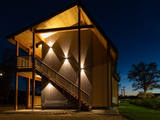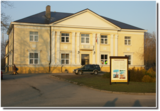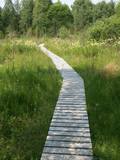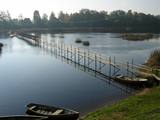| Nr | Name | Beschreibung |
|---|---|---|
|
Saimniecība nodarbojas ar 15 veidu vīna darīšanu no Latvijas augļiem, ogām un citām dabas veltēm, kā arī vīna destilāta ražošanu. Vīna darītavā vīndaris pastāstīs par vīna izgatavošanu un dalīsies savā pieredzē. Uz vietas iespējams nobaudīt dažādus izsmalcinātus augļu un ogu vīnus, meklējot sev tīkamākās garšu un smaržu nianses. Vīna darītava sadarbojas ar vietējo zemnieku saimniecībām, tēdēļ pie vīna iespējams nobaudīt sieru no govs vai aitas piena un Bauskas pusē ražotus saldumus. |
||
|
Auf den landwirtschaftlichen Flächen von 36 ha im Grenzgebiet zwischen Lettland und Weißrussland weiden Kühe, die pro Jahr ca. 10 Tonnen Milch geben, die vor Ort verarbeitet wird. Verkostung und Erwerb von Quark, saurer Sahne, Sahne, Käsespezialitäten, hausgemachtem Eis und Fleischerzeugnissen. Man kan auch an einem Herstellungsprozess teilnehmen. Teilnehmer des Netzes des kulinarischen Erbes Lettgallens. Biologische Landwirtschaft. |
||
|
Viens no diviem nacionālā parka skatu torņiem, kas atrodas ~ 1,5 km ziemeļos no Ehijerva ezera (Ähijärv). Tornis ir veiksmīgi „nomaskēts” nelielā priežu pudurī, tādēļ tas „nebojā” izcilo dabas un kultūrainavu, kas paveras no tā skatu platformas. Pie autostāvlaukuma ir izveidota labiekārtota atpūtas vieta. |
||
|
Bestes Apartments is a new guest house that can accommodate 45 guests at a time (+ 10 extra beds). The guest house was built and designed in the Latvian style (a wooden building made here in Mūrmuiža), beds made in Latvia, bed linen made in Latvia were used. |
||
|
The owner of the venue makes homemade wine on the basis of traditions that have been handed down from generation to generation. You can taste four different wines along with snacks and engage in philosophical discussions about winemaking recipes. You can also buy the wines. |
||
|
Уютное кафе в центре Тукумса. Время работы: пн. – сб. с 10:00 до 18:00; вс.- закрыто. |
||
|
Das Restaurant bzw. der Burgerladen "Raganas Burgers" ist auf 100% lettische Rindfleischburger, ausgewählte Pizzen und natürliche Pommes Frites spezialisiert. |
||
|
Das Gotteshaus wurde von 1742 – 1758 für die deutsche Gemeinde der Stadt nach einem Projekt von J.K. Dorn erbaut, der 55m hohe Turm wurde 1866 fertiggestellt. Die Fassade und das Interieur der Kirche sind im Spätbarock mit klassizistischen Zügen gehalten , im Interieur gibt es auch prunkvolle Elemente im Rokoko Stil. Das Gotteshaus ist bekannt für seine von 1773 – 1780 vom Halle’schen Orgelbauer Heinrich Andreas Contius erbaute Orgel . Nach dem Umbau von 1885 hat das Instrument heute über 7000 Pfeifen, 131 Register und 4 Manuale. Es gilt als die größte mechanische Orgel der Welt, es lohnt sich, sie in einem Konzert anzuhören! Besucher können Kirche und Orgel besichtigen und Kirchturm besteigen |
||
|
Das Gästehaus „Stikāni“ befindet sich 2 km von Nagli entfernt am Rand der Oreniši-Fischteiche. Im Gästehaus gibt es 4 bestens ausgestattete Doppelzimmer und ein Wohnzimmer mit Ausgang zur Terrasse. Auf dem zum Haus gehörenden Territorium ist ein Lehrpfad eingerichtet, wo man mit Führung mit den für Lettland typischen Bäumen und Sträuchern bekannt gemacht wird, ebenso mit den bekannten und mit weniger bekannten Heilpflanzen. Im Sommer auch mit den brütenden Vögeln im Frühling oder Herbst mit den hier reichlich anzutreffenden migrierenden Vögeln. |
||
|
Obwohl von den 104 Dorfhäusern im Ersten Weltkrieg 97 Häuser zerstört wurden, hat sich das Dorf Lapmežciems am Ende der 1930er Jahre schnell erholt, und da arbeitete eine der stärksten Fischergenossenschaften der lettischen Küste. Während der Sowjetzeit wurde hier eine der größten Fischerkolchosen Selga gegründet, deren Gebäude bei der Mündung des Flusses Siliņupe zu sehen sind. Heute ist Lapmežciems ein beliebter Sommerhäuserbezirk, Erholungs- und Badeort. Als ein interessantes Denkmal der Fischereigeschichte kann man hier die ehemalige Anlegestelle der Fischerboote von Lapmežciems besichtigen, wo die Fischer Netzhütten gebaut und ihre Werkzeuge aufbewahrt haben. Zwischen der Pīlādžu Straße und dem linken Ufer des Flusses Siliņupe befand sich vom 3. – 2. Jahrtausend v. Ch. eine Fischer- und Jägersiedlung, an deren Stelle ein Denkmal aufgestellt ist. Dieser Ort ist die älteste bekannte Siedlung auf dem Gebiet des Nationalparks von Ķemeri. Ein Teil der Funde kann man im Museum von Lapmežciems besichtigen, wo eine heimatkundliche Ausstellung eingerichtet und das Material über die Kämpfe der finnischen Jäger in der Umgebung von Klapkalnciems gesammelt worden ist. |
||
|
Das Wirtshaus befindet sich 5 km von Madona entfernt, am Nadelwald von Smecere. In dem Gebäude des Wirtshauses von Smecere (seit 17.Jh.) befindet sich ein Gästehaus, Wirtshaus und ein Musikklub. Lettische Küche: Pfifferlingsoße, graue Erbsen mit Speck, Gerstengrütze mit Fleischstücken, Haferbrei mit Marmelade, Kartoffelpfannkuchen, Stierhoden, Wildbret (Reh, Hirsch, Elch, Biber), gefülltes Ferkel. Das besondere Gericht: Forelle aus der eigenen Fischzüchterei. |
||
|
Barke von Peipussee ist ein Segelboot, das im Gebiet Peipussee und Fluss Emajõgi zum Gütertransport benutzt wurde. Spezielle für hiesige Verhältnisse passende Boote wurden schon im 14. Jahrhundert gebaut. Im Jahr 2006 hat man nach fünfzig Jahren Pause wieder eine Barke am Fluss Emajõgi gebaut und als „Jõmmu" genannt. Der Barke-Verein (Emajõe Lodjaselts) organisiert verschiedene Vergnügungsreisen auf dem Fluss Emajõgi und auf dem Peipussee. Die Barke "Jõmmu" wartet auf kleinere Barke-Fans, um die traditionelle Handwerk und Schiffbau zu präsentieren. |
||
|
Atrodas Grobiņas centrā, Dzērves laukuma malā. Pirmā baznīca Grobiņa bija celta jau ap 1560. g., bet nākamā – 1596. g. celtā iznīcināta 1659. g. zviedru iebrukuma laikā. Pēc Kurzemes un Zemgales hercoga Jēkaba Ketlera iniciatīvas 1664. g. tiek uzcelts jauns dievnams, ko atjauno 1892. gadā. Tas dedzis 2. pasaules kara laikā, bet vēlāk atkal atjaunots. Šobrīd notiek altāra restaurācijas darbi. |
||
|
1,2 km garā taka atrodas netālu no vietas, kur Gauju šķērso Vidzemes šoseja (A 2). Izejot taku, var iepazīt vienu no Latvijas augstākajiem dolomītiežu atsegumiem – Randātu klintis, kas paceļas 25 m virs Gaujas. Taka ir apļaveida un tās apskatei nepieciešamas ~ 45 minūtes. |
||
|
Dieses kleine Schutzgebiet schützt die Schwedischen Wacholderbüsche und die grünen Wiesen, auf denen sie wachsen. Es gibt einen markierten Rundgang, der es den Besuchern erlaubt, einen der wenigen, aber ausgezeichneten Bestände des Wacholders in Lettland zu studieren. Die Büsche sind 50 bis 70 Jahre alt und um sie herum gibt es interessante Biotope, Pflanzen und Tiere. Der natürliche Wacholderbestand in den Baltischen Staaten ist das Ergebnis von Landarbeiten wie z.B. Mähen, Ernten usw. und dem Hüten von Schafen und anderen Tieren. Ein kleiner Teil dieses Gebietes wird immer noch von Schafen “gemanaged”.
|
||
|
Ap 400m garš un līdz 16m augusts atsegums upes kreisajā krastā.
|
||
|
Der Pfad liegt an der Küste der Rigaer Bucht, man kann kleinere Buchten und Landspitzen betrachten, die Küste ist steinig oder zugewachsen. Am Ende des Pfades befindet sich ein Ausichtsturm zur Vogelbeobachtung, denn im Frühling und in der Zeit des Vogelzugs sammeln sich in der Umgebung von Kaltene vielfältige Gänsevögel, Regenpfeiferartige und andere Vogelarten.
|
||
|
Die Flüsse Salaca und Svētupe sind zu den einzigen Orten auf der Welt ernannt, wo man beim industriellen Fischfang der Neunaugen immer noch eine mehr als 150 Jahre alte Methode benutzt: den Fischzaun (einen über den Fluss gebauten Steg mit Fischreusen, insgesamt drei Fischzäune). Unter der Leitung der örtlichen Fischer kann man die Fischzäune besichtigen, den Fischfang beobachten und Vorort gegrillte Neunaugen probieren. |
||
|
This company has, for the past 16 years, produced classical candies of honey, peppermint, ginger and buckthorn, as well as other products. It also offers juice made of the common stinkhorn mushroom – a medicinal substance well known in Latvian folklore. You can purchase the products that are on offer. |
||
|
0,2 km austrumos no Vidsmuižas atrodas no šķeltajiem laukakmeņiem un sarkanajiem ķieģeļiem celtā (1910. - 1912. g.) Vidsmuižas katoļu baznīca. Tāpat kā Riebiņos esošā, arī šī ir uzskatāma par tipisku 19. – 20. gs. mijas Latgales lauku baznīcas paraugu. |
||























